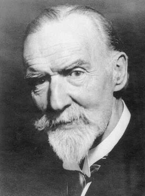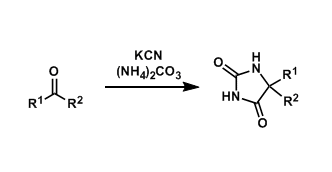- Generality
- Reagent Availability
- Experimental User Friendliness
- Criteria #4
- Criteria #5
-
General Characteristics
Hydantoins can be synthesized from the corresponding ketones or aldehydes using potassium cyanide and ammonium carbonate.
-
General References
- Bergs H, DE, 566, 094, 1929
- Bucherer, H. T.; Fischbeck, H. T.; J. Prakt. Chem. 1934, 140, 69.
- Bucherer, H. T.; Steiner, W. J. Prakt. Chem. 1934, 140, 291.
- Ware, E. Chem. Rev. 1950, 46, 403. doi:10.1021/cr60145a001
- Rousset, A. et al. Tetrahedron 1980, 36, 2649. doi:10.1016/0040-4020(80)80137-2
- Sarges, R. et al. J. Med. Chem. 1990, 33, 1859. DOI: 10.1021/jm00169a005
-
History
In 1929, Bergs reported by patent that 5-substituted hydantoin could be synthesized by reacting aldehyde or ketone with potassium cyanide, ammonium carbonate, and carbon dioxide. A few years later, a German chemist Bucherer reported the same reaction in 1934. Bucherer is also recognized for discovering other reactions, such as the synthesis of carbazole by heating naphthol and hydrazine in sodium bisulfite (the Bucherer carbazole synthesis) and the conversion of naphthol into naphthylamine using ammonia in sodium bisulfite (the Bucherer reaction). 
-
Reaction Mechanism
-
Examples
-
Experimental Procedure
-
Experimental Tips
-
References
- Sarges, R.; Goldstein, S. W.; Welch, W. M. J. Med. Chem., 1990, 33, 1859. DOI: 10.1021/jm00169a005
-
Related Reactions
-
Related Books
[amazonjs asin=”0199257388″ locale=”US” title=”Amino Acid and Peptide Synthesis (Oxford Chemistry Primers)”]
-
External Links
- Bucherer-Bergs Reaction (organic-chemistry.org)
- Bucherer-Bergs reaction – Wikipedia


